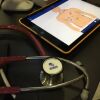At EMS Today in Washington DC this week Pulmodyne introduced a new model called the O2Max Trio. This is a completely original design. It makes delivering CPAP much easier and much more effective for EMS providers.
I’ve been a huge fan of Continuous Positive Airway Pressure (CPAP) since it was first introduced to EMS about 7-10 years ago. CPAP has been shown to definitively manage serious respiratory emergencies such as congestive heart failure, chronic obstructive pulmonary disease and asthma.
CPAP stands for Constant or Continuous Positive Airway Pressure. It raises both inspiratory and expiratory pressures in the lungs above normal atmospheric pressure. When the patient inhales, they get a blast of gas that makes it easier for them to inhale. When they breathe out, it is against a pressure resistance that opens tiny airways and improves ventilation.
Other disposable devices use the Bernoulli principle to generate the pressure necessary to maintain open airways. The O2Max Trio uses the pressure with the oxygen tank to function.
The Trio not only delivers PEEP, it also delivers positive inspiratory pressure. The first two Pulmodyne disposable CPAP devices were very similar to the very first CPAP on the market, the original Downs Flow Generator.
The first two Pulmodyne disposable CPAP units were basically disposable copies of the original Downs Flow. With this new device, they have stepped outside of the box to create an entirely new and original design.
It attaches directly to your DISS high-pressure port on an EMS regulator. That means it can exceed patient inspiratory flow demand. A DISS port can supply unregulated flows of at least 60-100LPM.
For those new to EMS; a DISS port supplies oxygen at straight 50psi. Think of it as a much bigger hole. With a regular indexed oxygen flow meter you hook your O2 mask to a small nipple. The nipple’s maximum pressure is also 50psi, but regulated to a much lower maximum flow rate. A DISS port is huge by comparison and permits flow rates far higher than are possible on a “Christmas Tree”.
This is what makes it possible to deliver inspiratory flow in excess of inspiratory demand. It helps patients inhale and increases inspiratory pressures to therapeutic levels.
The Trio is easy and intuitive to use. It puts the Paramedic in charge of all the critical variables. The Paramedic selects the FIO2 and PEEP pressure separately with two simple click selectors that are both clearly labeled.
For example; if you have a real sick patient you can crank up the FIO2 until they respond and SAO2’s improve. Then you can dial FIO2 down to extend tank life once you have matters well in hand.
FIO2 can be 30%, 60%, or 90%. That pretty much covers every situation. It also has selectable variable PEEP. It goes from 2.5cm PEEP to 20cm PEEP, which covers every conceivable clinical requirement for expiratory pressure support.
There are an amazing 21 possible combinations. With a little practice and training, this incredible range of setting puts you in total charge of every respiratory distress situation.
What improves alveolar exchange isn’t the FIO2; it’s the pressure support. That is what open up tiny airways and facilitates gas exchange. CPAP is raising both inspiratory pressures and expiratory pressures above atmospheric according to Webster’s Dictionary.
Simple controls, an entirely original design, and sophisticated functionality converge to create what I think is a great new disposable CPAP device for EMS. For more information check out http://pulmodyne.com or contact their EMS distributor Bound Tree Medical.
If you are a busy ALS unit I recommend either a stand alone true EMS CPAP machine, or a good EMS Ventilator with a CPAP function. If you are either a not so busy ALS or a BLS unit, the disposables do make great sense.
The Trio is for those that don’t do CPAP every day or don’t want to invest in expensive capital equipment.



